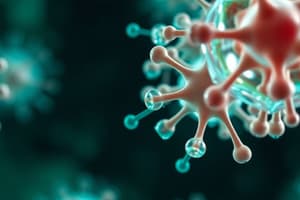Podcast
Questions and Answers
What is the formula for all monosaccharides?
What is the formula for all monosaccharides?
- (CH2O)n-1
- (CH2O)n (correct)
- (CHO)n
- (CH2O)2n
Which type of monosaccharide is ketone based?
Which type of monosaccharide is ketone based?
- Triose
- Ketose (correct)
- Tetrose
- Aldose
How is the number of carbon atoms in a monosaccharide used to determine its name?
How is the number of carbon atoms in a monosaccharide used to determine its name?
- By using suffixes like triose, tetrose, pentose, etc.
- By using alphabetical orders like alose, blose, close, etc.
- By using prefixes like triose, tetrose, pentose, etc. (correct)
- By using numerical values like 1ose, 2ose, 3ose, etc.
What type of bond releases H2O upon formation in disaccharides?
What type of bond releases H2O upon formation in disaccharides?
What is the primary function of body fats?
What is the primary function of body fats?
Which molecule can intercalate into the membrane and reduce permeability for soluble molecules?
Which molecule can intercalate into the membrane and reduce permeability for soluble molecules?
What stabilizes the tertiary structure of proteins?
What stabilizes the tertiary structure of proteins?
What is the function of nucleotides as second messenger?
What is the function of nucleotides as second messenger?
What causes diabetes (insulin-dependent)?
What causes diabetes (insulin-dependent)?
What makes DNA much more stable than RNA?
What makes DNA much more stable than RNA?
What is the general formula for carbohydrates?
What is the general formula for carbohydrates?
What proportion of the total cell weight do macromolecules constitute?
What proportion of the total cell weight do macromolecules constitute?
Which type of biological molecules are carbon-based, except for some small inorganic molecules?
Which type of biological molecules are carbon-based, except for some small inorganic molecules?
What are the most common organic compounds on earth?
What are the most common organic compounds on earth?
What is the function of small molecules in cells?
What is the function of small molecules in cells?
Which category do lipids/fats belong to?
Which category do lipids/fats belong to?
What do proteins associate to form?
What do proteins associate to form?
Flashcards are hidden until you start studying
Study Notes
Monosaccharides
- The general formula for all monosaccharides is (CH2O)n.
- Ketose-based monosaccharides are a type of monosaccharide that contain a ketone group.
Naming Monosaccharides
- The number of carbon atoms in a monosaccharide determines its name, with trioses having three carbon atoms, tetroses having four, and so on.
Disaccharides
- A glycosidic bond, which releases H2O upon formation, connects two monosaccharides in a disaccharide.
Functions of Biomolecules
- The primary function of body fats is to provide energy and insulation.
- Nucleotides function as second messengers, sending signals within cells.
- Proteins associate to form quaternary structures.
Lipids
- Lipids/fats belong to the category of biomolecules that are carbon-based, except for some small inorganic molecules.
DNA and RNA
- DNA is more stable than RNA because it is a double-stranded molecule.
Carbohydrates
- The general formula for carbohydrates is (CH2O)n.
Cell Composition
- Macromolecules, such as proteins, carbohydrates, and nucleic acids, constitute about 90% of the total cell weight.
Biological Molecules
- Organic compounds, such as carbohydrates, proteins, and lipids, are the most common type of biological molecules on earth.
- Small molecules, such as glucose and ATP, play a crucial role in cells, serving as energy sources and building blocks for larger molecules.
Protein Structure
- Hydrogen bonds, ionic bonds, and disulfide bonds stabilize the tertiary structure of proteins.
Diabetes
- Insulin-dependent diabetes, also known as Type 1 diabetes, is caused by the inability of the body to produce enough insulin.
Membrane Structure
- Cholesterol molecules can intercalate into the membrane, reducing permeability for soluble molecules.
Studying That Suits You
Use AI to generate personalized quizzes and flashcards to suit your learning preferences.




